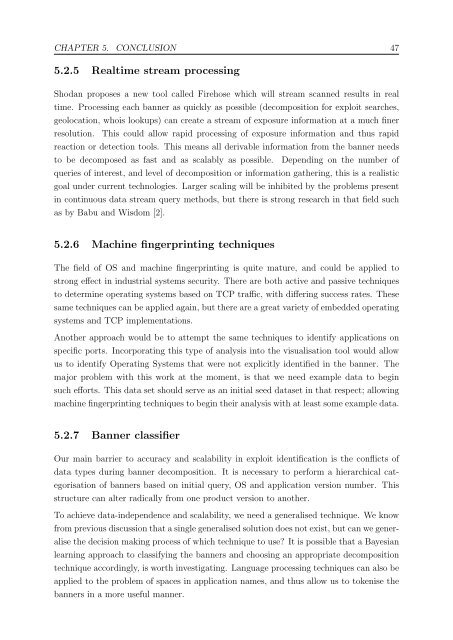Quantitatively Assessing and Visualising Industrial System Attack Surfaces
Quantitatively Assessing and Visualising Industrial System Attack Surfaces
Quantitatively Assessing and Visualising Industrial System Attack Surfaces
Create successful ePaper yourself
Turn your PDF publications into a flip-book with our unique Google optimized e-Paper software.
CHAPTER 5. CONCLUSION 47<br />
5.2.5 Realtime stream processing<br />
Shodan proposes a new tool called Firehose which will stream scanned results in real<br />
time. Processing each banner as quickly as possible (decomposition for exploit searches,<br />
geolocation, whois lookups) can create a stream of exposure information at a much finer<br />
resolution. This could allow rapid processing of exposure information <strong>and</strong> thus rapid<br />
reaction or detection tools. This means all derivable information from the banner needs<br />
to be decomposed as fast <strong>and</strong> as scalably as possible. Depending on the number of<br />
queries of interest, <strong>and</strong> level of decomposition or information gathering, this is a realistic<br />
goal under current technologies. Larger scaling will be inhibited by the problems present<br />
in continuous data stream query methods, but there is strong research in that field such<br />
as by Babu <strong>and</strong> Wisdom [2].<br />
5.2.6 Machine fingerprinting techniques<br />
The field of OS <strong>and</strong> machine fingerprinting is quite mature, <strong>and</strong> could be applied to<br />
strong effect in industrial systems security. There are both active <strong>and</strong> passive techniques<br />
to determine operating systems based on TCP traffic, with differing success rates. These<br />
same techniques can be applied again, but there are a great variety of embedded operating<br />
systems <strong>and</strong> TCP implementations.<br />
Another approach would be to attempt the same techniques to identify applications on<br />
specific ports. Incorporating this type of analysis into the visualisation tool would allow<br />
us to identify Operating <strong>System</strong>s that were not explicitly identified in the banner. The<br />
major problem with this work at the moment, is that we need example data to begin<br />
such efforts. This data set should serve as an initial seed dataset in that respect; allowing<br />
machine fingerprinting techniques to begin their analysis with at least some example data.<br />
5.2.7 Banner classifier<br />
Our main barrier to accuracy <strong>and</strong> scalability in exploit identification is the conflicts of<br />
data types during banner decomposition. It is necessary to perform a hierarchical cat-<br />
egorisation of banners based on initial query, OS <strong>and</strong> application version number. This<br />
structure can alter radically from one product version to another.<br />
To achieve data-independence <strong>and</strong> scalability, we need a generalised technique. We know<br />
from previous discussion that a single generalised solution does not exist, but can we gener-<br />
alise the decision making process of which technique to use? It is possible that a Bayesian<br />
learning approach to classifying the banners <strong>and</strong> choosing an appropriate decomposition<br />
technique accordingly, is worth investigating. Language processing techniques can also be<br />
applied to the problem of spaces in application names, <strong>and</strong> thus allow us to tokenise the<br />
banners in a more useful manner.



